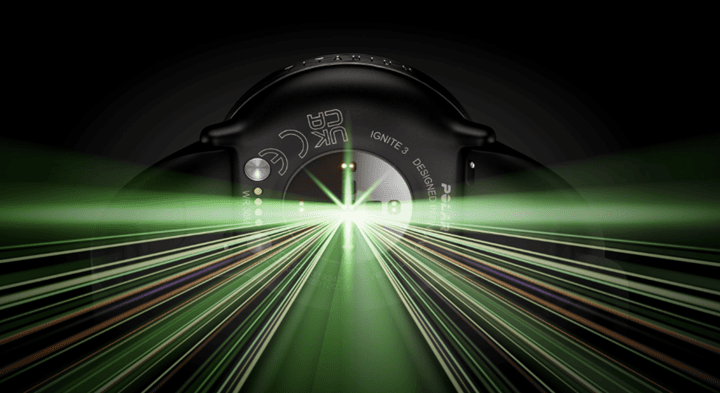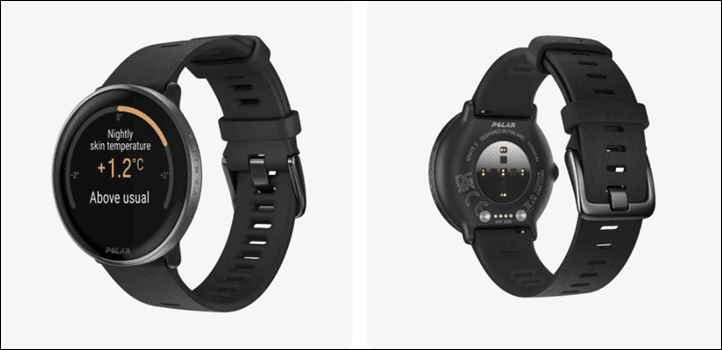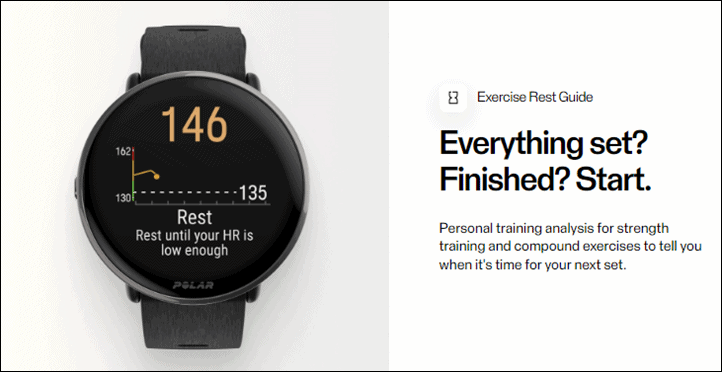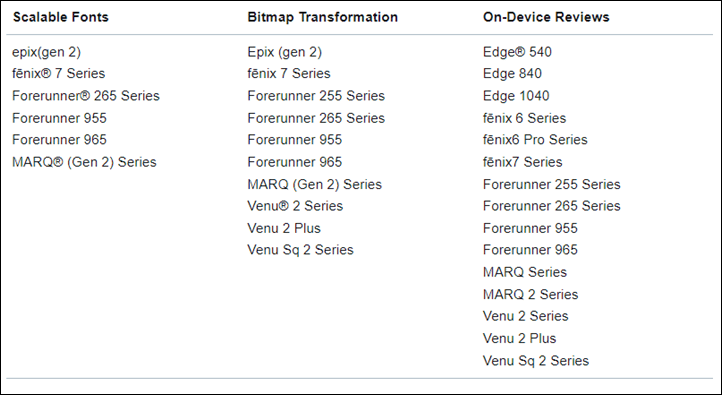Over the last week there’s been a few notable updates that are worth mentioning, even if briefly. Thus, this will be the post for it. It’s like the ‘Tidbits’ posts I usually do, except being all watches. Less random, and perhaps, a bit less exciting. But hey, such is life after the exciting spring swing of new watch launches. Mid-June till mid-August tends to be the quiet season for new watches, with the next big wave likely starting again in late August for more mainstream-consumer type watches, as is annually how it works.
In any case, here’s what’s notable.
Polar Adds Skin Temperature Sensing:
Last week Polar announced a new watch, the Polar Ignite 3 Titanium. Except, it wasn’t really new. It was just a new bezel material option for the existing Polar Ignite 3 from last fall. I don’t tend to cover case/material, or (if you want to sound fancy) color changes, unless there are some other notable bits alongside. In this case, there actually are notable bits: The newly added nightly skin temperature sensing.
We’ve seen a few other wearables add this in recent years, albeit at different levels. Starting waaaay-back there was Basis and their watches, then Fitbit over the last few years, and more recently we’ve had Whoop, Oura, and Apple all add it. In general, most show relative changes (e.g., +1.5°F from your baseline), rather than exact numbers (e.g., 99.2°F). That’s somewhat because skin-temperature sensing accuracy is messy here, and it allows companies to be a bit more nebulous with it. But also, because the thing that actually matters here tends to be relative changes. Most consumers don’t know what it means to have skin temperature 99.2°F vs 97.2°F (or your non-Americana values).
So what use is skin temperature? Well, the biggest driver today is women’s health, specifically detecting upcoming menstrual cycles (or, detecting it after the fact). There’s a mix of how companies do this, with some like Oura being pretty darn good at detecting upcoming cycles, and then those like Apple that show changes in temperature – including within women’s health metric areas, but don’t predict what’s coming cycle-wise. And then finally, those like what Polar is doing here, which is tracking the temperature shifts and just leave it at that. Often, companies do temperature sensing first, then women’s health prediction stuff later.
Finally, temperature shifts can also be indicating the onset of illness. Of course, it can be that it was simply a hot summer night where your sweated all night in your bed, or inversely, I find on overnight flights with usually colder plane temps, you’ll see a drop in skin temperatures).
In any case, as for Polar, the platform uses the sensor on the back of the watch to measure your skin temperature while sleeping. It’ll show this data in two places. The first is on the watch each day, for last night’s sleep:
And the second is within the Polar Flow app, where you can see trending data over time. Undoubtedly Polar is looking at leveraging this data for more specific forward-looking recommendations/advice, but at the moment it’s just giving historical data.
Beyond that, Polar also added a new “Work-Rest Guide Training Analysis”. That’s an alphabet soup of fitness terms, but essentially what it does is during interval or HIIT workouts it’ll dynamically tell you when to start your next interval – rather than a set time period. It uses your heart rate data to determine this.
In fact, Polar even has an entire white paper on how they developed this, which you can read here. I’ve always appreciated Polar documenting this information in more depth than just a marketing blurb.
Polar says the existing Polar Ignite 3 users get this as part of the 2.0 software update. There are no other plans to announce for other products getting the update at this time.
Pixel Watch & Fitbit Updates:
Google has continued to ever-so-slowly add new features to the Pixel Watch they released last fall, and the most recent update focuses heavily on heart rate, finally lighting up the SpO2 sensor that was seen at launch. Now, data is actually used from that. With the update, the unit will track your SpO2 levels during sleep, which can be seen both within the watch, as well as on the companion smartphone app. Additionally, they’ve now added high and low heart rate notifications (for 24×7 usage, not specific to sport zones):
And then beyond that, they have:
– Added Google Assistant on Wear OS in five new languages: Italian, Portuguese, Swedish, Polish, and Spanish.
– Added three new Spotify tiles: Spotify DJ session, podcasts, and heavy rotation
– Added auto pause during workouts to running, walking, and cycling
And finally on the Pixel Watch front, they’ve launching a Metal Links band, which does have the ability to add/remove links as required.
Next, good news, existing Fitbit devices aren’t dead! Despite a long cold winter of Google (or Fitbit) killing off Fitbit features, spring sprung and it got a few new things:
– Exercise Modes will now automatically sort the most recently used modes to the top, versus having to do it on the mobile phone app (Charge 5, Luxe, Inspire 3)
– Daily Readiness Score is now available on the watch for a quick glance (All Fitbit watches that support Daily Readiness on the platform)
– New Menstrual Health Tile to log periods, view cycle state, and edit information (Sense 2 and Versa 4)
– Notification support added in more languages, including Hindi, Arabic, and Vietnamese, notably for right-to-left text (Sense 2, Versa 4, Charge 5, Luxe, and Inspire 3.
– Added Changing watchface/clock styles directly from your wrist via long-hold (Sense 2 and Versa 4)
– Added four new watchface/clock styles, notably bringing the most popular Charge 5 clock face to the Luxe and Inspire 3)
Got all that? And again, it’s good to see that there’s actually still active development going forward on Fitbit devices.
Garmin Connect IQ Refresh:
Connect IQ is Garmin’s app development platform, where all the 3rd party apps run. Historically speaking, Garmin announces a new major version each fall, and then we see minor updates the rest of the year. Different devices qualify for different components within that. So a newer fancy AMOLED display device may unlock more new display features than a slightly older MIP-based display. And further, sometimes it’s simply more processing power or such that unlocks features. And lastly, sometimes it’s “just cause” that older devices don’t get new developer features.
First up, Garmin is changing the Connect IQ SDK numbering scheme, which will no longer be in sync with the Connect IQ API version, so the new numbering scheme will be below, which in theory matches the Connect IQ system level shown to users.
For example, you can see this below, which is what’s shown on the watches (and firmware update release notes), when there are new things added:
At first this seemed confusing to me, as I thought the API level was being shown to users, but in digging further, it looks like Garmin is noting the system level in release notes too:
Next, there’s a handful of things that again, mostly only developers will care about. You can read the full details here, but in short:
– Added scalable fonts and new syntaxes to use
– Added bitmap transformations
– Apps can now request user reviews – so you as a user/consumer can rate apps
– Adds support for RedShift in the Connect IQ simulator
The devices supporting this are as follows:
And thus, my work here is complete.
—
With all that covered, I’ve got plenty more from Eurobike still to come. I had planned this post to go out last weekend, but it kept getting delays while getting clarifications. As for Eurobike, I’m going to make it a goal to not buy another cargo bike, but frankly, I can’t make any promises.
Thanks for reading!
FOUND THIS POST USEFUL? SUPPORT THE SITE!
Hopefully, you found this post useful. The website is really a labor of love, so please consider becoming a DC RAINMAKER Supporter. This gets you an ad-free experience, and access to our (mostly) bi-monthly behind-the-scenes video series of “Shed Talkin’”.
Support DCRainMaker - Shop on Amazon
Otherwise, perhaps consider using the below link if shopping on Amazon. As an Amazon Associate, I earn from qualifying purchases. It doesn’t cost you anything extra, but your purchases help support this website a lot. It could simply be buying toilet paper, or this pizza oven we use and love.
























Are on device reviews slated for the EPIX2? It isn’t on the list but the Fenix7 is. And they are both on the other lists.
So are we finally seeing the definitive divergence between the 955 and 945LTE? It’s beginning to look like the 945LTE is not going to get System 6.
Looks like it. I was hoping they’d at least let us adjust data screens from the Connect app, but that never happened.
Hi Ray,
The “Work-Rest Guide Training Analysis” is not new – Polar did have this feature on the old FT60 and FT80 way back in 2007 – I had the FT80 and it would tell me when I was ready for my next set
Thanks,
Munz
IMO Polar has 2 (or more) different timelines realistically in their devices/features history “pre-Vantage” and “post-Vantage”. Polar effectively (with the exception of m430) pretty much took 3 years off releasing anything (while trying to figure out the new chipset integrations on what would become Vantage), then became “Polar 2.0, Vantage timeline” (Kind of like Star Trek reboots, LOL). “Whatever happened before, no longer exists in Polar-verse, LOL”. That’s the feeling I have had for years anyhow, basically they changed the core hardware, had to redevelop the entire OS around the new hardware stacks, seem to have hired a bunch of devs for the new OS dev that had no idea how good, stable, reliable, Polar was known for in past history, and advanced the “spec sheet” while drawing back in the quality, reliability, stability, and “it just works and works wellness” of their products.
Except the m430, that was “Spock” in Star Trek terms, making guest appearances across all timelines and such, LOL.
Just my take on it in general, really there are 3.5 eras:
Era 1 – “independent device” era (pre-internet sync platforms, when you just used a spreadsheet/paper to track your post-workout data) (and I could design custom watch faces for at least one of my models, that was fun, although the audio-sync made that quite challenging, LOL!)
Era 2 – The PPersonT/PProT era (when things really worked great, and you could have manual input, synced input, and modifiable data (and extra data, blood pressure, temperature, and dozens of other “hand-entered” metrics in their local and web platforms… the good-old-days…)
Era 2.5 the Polar Flow with still reliable devices era – pre-Flow devices and their data sync kinda worked still, the still-supported devices were still great, the platform much less so from a data perspective (prettier, but less data metrics actually supported, and can’t edit/crop workouts).
Era 3 – The post Vantage era, when all previous eras were forsaken in favor of “more hardware” specs color, touchscreens, less accurate OHRs and GPS (compared to the least era 2.0/2.5 devices), but less reliable software and muddling/loss of features (which mostly have now found their way back finally) from the last 2.5 device (v800).
Anyhow, current Polar marketing, management, “public facing” entities, seem to REALLY want everyone to forget the 2.0/2.5 era and before, ever existed. I think it’s because they (SOMEONE there at least) know, their “things” today, aren’t as good (in relative terms) to their devices “then” and it’s a spot of contention that they have yet to get back to that “it just works and does it’s job well/perfectly” quality they used to be praised for (their biggest 2 selling points in the old days were “we do what we do, better than anyone” and “our devices just work, period”.
Garmin couldn’t claim either of those as better than Polar through the late 201x years, but now it’s flipped, and Garmin is “just as reliable (both are a bit flakey now, instead of that just being the knock against Garmin”) in my personal usage/experience of both, and has MUCH better GPS and similar OHR accuracy, but has a lot more to offer as well than similar market-level Polar devices.
Not a good place for Polar to be in, but hey, at least their low-midgrade watch has a Ti bezel option now.
(I’m off to go use my v800 with my Polar Balance scale to automatically record my weight, check the current ambient temperature from my wrist, record my current waypoint and altitude, setup some custom intervals, setup a race pace to try for my training run, see and skip a song on spotify from my watch, get my phone notifications (not while working out sadly, that only came post-v800 and yeah, it’s partial, but enough to get the idea most of the time), record running cadence from the wrist, or sync my Stryd and get accurate power, speed, and cadence recorded and displayed on the watch via fully customizable screen/data views, go for a swim with live HR reporting from my chest strap while swimming (and accurate swim stroke tracking and open-water GPS recording that doesn’t fail halfway through a workout, then maybe sync up some Strava segments to my v800 and later start a video recording remotely on my GoPro from across the room so I am ready to start recording, all from my 7-year-old watch…) Polar today, doesn’t want people to remember that a LONG list of their “latest features” the past 5 years or so, was re-releasing things they’d already done in the “before times”.
(And yes, I’m NEVER going to forget, or give-up on, those “before” times, in hopes that SOMEHOW Polar today, can find their way BACK to the “it just works” feel of those days, while progressing the platform forward in meaningful ways, because I don’t know when to give up, LOL).
Ray, if you’re ever looking for an assistant/ghostwriter ^^^^^
Interesting take on this. I’d say it a bit more simply: seems like Polar has always been a health research first company. They’ve gotten distracted chasing high end hardware and losing to Garmin for years. Now maybe trying to switch back to health/”algorithm” focus again maybe? No new “flagship” device in almost 3 years, licensing their algorithms, and I thought they just had some layoffs. Tough sledding for Polar, I hope they can figure it out. Hard to develop new algorithms long term without adding new sensors (aka new devices), curious what they release next. Personally I’d love to see them go to 3 year flagship hardware cycle, but support and develop every product with quarterly or frequent updates. Best of all worlds, if the business model is there.
This is a great article on its own.
Thank you for this comment! Im 100% with you.
Polar really dont know what to do. Theyre not best at gps tracking or ohr. They dont even have best hr underwater (they killed their own tech – 5khz transmission, real time hr underwater!). So what are they the best?
My opinion: selling soft updates for the price of new watch. Shortest update time of existing models (even flagship models). Bringing back functions from previous watches and advertising it as great and new functions.
They cut explore function, clubs, groups from Polar Flow. They cut off “feed” option and comments. They cut off biking computers (still selling m460 but dont support with new updates!).
Worst thing for me is… almost all new functions which work on v800 and vantage v2 is better on v800! Navigation – v800 got POI, automatic change direction (not with menus like on v2).
Strava segments – you have list on v800, during activity info about 2 upcoming segments and when you pause segment it appear next time (on v2 canceling “closes” this segment for this activity), you had hr during racing with strava segment
Race pace – on v800 you had “average time to arrive on time” real time changing with our speed, that was really a handy function but hey! On v2 you have dude running or cycling xD.
And battery time… Coros have weeks of battery time, Garmin and suunto have weeks of battery time. Polar only days.
Big Polar fan here but not fanatic. I see what they did to my beloved brand. I wait till end of this year to make a switch, unfortunately.
Thank you for all of this John. I’m wondering what you might switch to? I might follow suit, as I’ve grown tired of Polar with how they have been “acting”.
Good reviews and news as always!
Thx
There’s a typo in the article. In the polar section near the bottom discussing the interval and hiit training . Interval is spelled internal
Thanks for the nice coverage of the Polar update. A few of us still in the polar camp, I know I appreciate the coverage. 👍
Typo: “what it does is during internal or HIIT workouts” should be interval. :-)
Thanks!
Hi Ray! On a Fenix 6x (and probably many other sportwatches as well), you could easily create a HIIT-session, there the next step in the interval session will not start before your HR drops below a certain value.
How will Polar’s new interval differs from that?